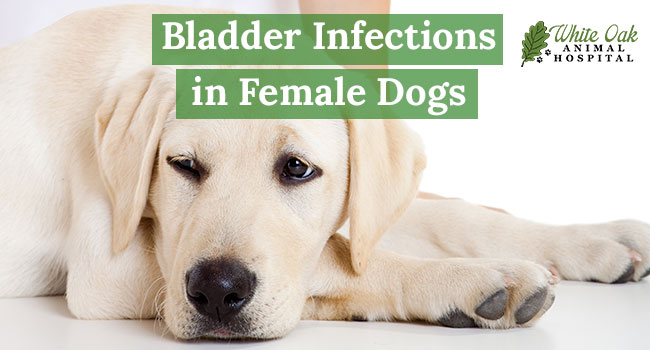
Bladder infections in female dogs are a common and painful issue that can affect any breed or age. These infections occur when bacteria enter the urinary tract and multiply, causing discomfort and other health problems. Female dogs are more prone to bladder infections than male dogs due to their shorter urethra, which makes it easier for bacteria to reach the bladder. Early detection and treatment of bladder infections in female dogs are crucial to prevent the infection from worsening and causing more severe health issues. Recognizing the signs of a bladder infection and seeking prompt veterinary care can make a significant difference in your dog’s health and comfort.
II. Understanding Bladder Infections in Female Dogs
A. What Causes Bladder Infections?
Bladder infections in female dogs are typically caused by bacteria entering the urinary tract. Common causes include poor
B. Symptoms to Watch For
III. Diagnosing a Bladder Infection in Female Dogs
A. Veterinary Examination
A veterinary examination is the first step in diagnosing a bladder infection in female dogs. The vet will perform a physical examination to assess your dog’s overall health and check for any signs of pain or discomfort in the abdominal area. This examination is crucial in determining if further diagnostic tests are needed to confirm a bladder infection in female dogs.
B. Diagnostic Tests
Urinalysis
Urine Culture and Sensitivity Test
A urine culture and sensitivity test are often recommended to pinpoint the specific bacteria causing the bladder infection in female dogs. This test allows the veterinarian to determine the most effective antibiotic to treat the infection, ensuring a more targeted and effective treatment plan for the bladder infection in female dogs.
IV. Three Effective Solutions for Treating a Bladder Infection in Female Dogs
A. Antibiotic Treatment
1. When Antibiotics Are Necessary
2. Monitoring and Adjusting Treatment
Monitoring your dog’s response to antibiotics is crucial in managing a bladder infection in female dogs. If symptoms persist or worsen, contact your veterinarian, who may adjust the treatment plan or recommend additional tests to ensure the bladder infection in female dogs is effectively managed.
B. Dietary Adjustments
1. Importance of Diet in Prevention and Recovery
Diet plays a significant role in preventing and managing bladder infections in female dogs. A balanced diet rich in nutrients that support urinary health can help reduce the risk of infections. Certain foods and supplements, such as those containing cranberries or antioxidants, may help maintain bladder health and prevent bladder infections.
2
Proper hydration is essential for preventing and recovering from bladder infections in female dogs. Ensuring your dog drinks enough water helps flush bacteria out of the urinary tract, reducing the risk of infection. Encouraging regular water intake can be an effective measure in preventing bladder infections.
C. Integrative and Natural Remedies
1. Herbal Supplements and Natural Therapies
Some pet owners consider herbal supplements and natural remedies as part of the treatment for bladder infections in female dogs. Herbs such as uva ursi, marshmallow root, and cranberry extract found in Dr. Damron’s PET | TAO Soothe Bladder Supplement are believed to support urinary health and may complement traditional treatments for bladder infections. Traditional Chinese Veterinary Medicine (TCVM) offers integrative approaches that some find helpful.
2. White Oak Animal Hospital’s Integrative Approach
White Oak Animal Hospital incorporates integrative medicine into its treatment plans for bladder infections in female dogs. Their approach includes telemedicine consultations and personalized care options, which can be particularly beneficial for managing chronic or recurrent bladder infections.
Prevention Tips to Avoid Bladder Infections in Female Dogs
Regular veterinary checkups are essential in preventing bladder infections in female dogs. During these visits, your veterinarian can monitor your dog’s urinary health, offer early detection strategies, and provide preventive care advice. Consistent checkups are a proactive approach to maintaining bladder health in female dogs.
Maintaining a healthy lifestyle for your dog can help prevent bladder infections. This includes providing a balanced diet, ensuring regular exercise, and practicing good hygiene. Keeping your dog at a healthy weight and encouraging regular urination can also reduce the risk of bladder infections.
Bladder infections in female dogs are a significant health concern that requires prompt attention and appropriate treatment.
Frequently Asked Questions
How can I tell if my dog has a bladder infection?
To determine if your dog has a bladder infection, watch for common symptoms such as frequent urination, straining, blood in the urine, and discomfort while urinating. If you notice any of these signs, consult your veterinarian promptly. Timely diagnosis and treatment of bladder infections are crucial to prevent more severe complications.
Can bladder infections in dogs go away on their own?
Bladder infections in dogs typically do not go away on their own and require veterinary treatment. If left untreated, a bladder infection can worsen and lead to more severe health problems, such as kidney infections or bladder stones. It’s essential to seek veterinary care to address the infection appropriately.
What can I do to prevent bladder infections in my dog?
Preventing bladder infections involves a combination of proper diet, hydration, regular vet visits, and maintaining good hygiene. Ensuring your dog has access to clean water, a balanced diet, and regular exercise can help keep their urinary system healthy. Additionally, White Oak Animal Hospital offers preventive care strategies to help manage your dog’s long-term health effectively.